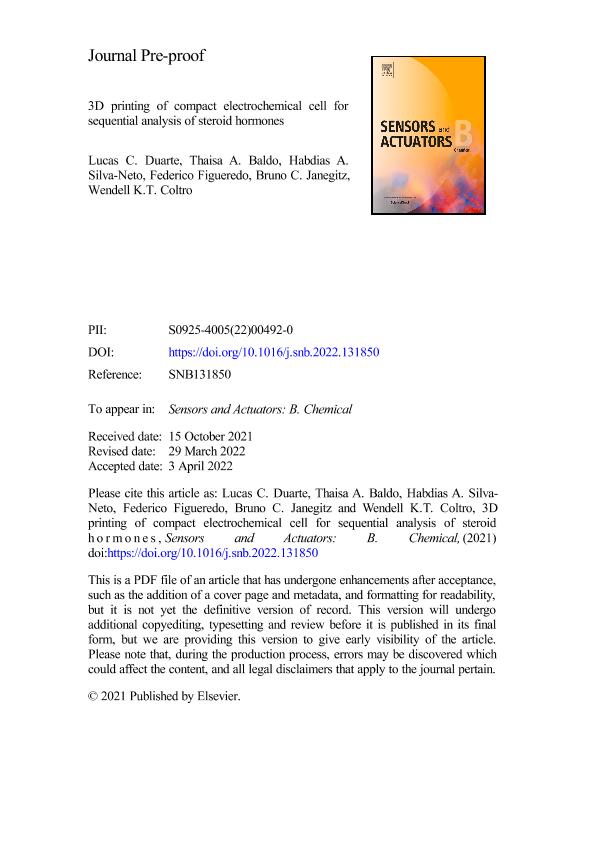Artículo
3D printing of compact electrochemical cell for sequential analysis of steroid hormones
Duarte, Lucas C.; Baldo, Thaisa A.; Silva Neto, Habdias A.; Figueredo, Federico ; Janegitz, Bruno C.; Coltro, Wendell K.T.
; Janegitz, Bruno C.; Coltro, Wendell K.T.
 ; Janegitz, Bruno C.; Coltro, Wendell K.T.
; Janegitz, Bruno C.; Coltro, Wendell K.T.
Fecha de publicación:
08/2022
Editorial:
Elsevier Science SA
Revista:
Sensors and Actuators B: Chemical
ISSN:
0925-4005
Idioma:
Inglés
Tipo de recurso:
Artículo publicado
Clasificación temática:
Resumen
3D printing technology revolutionized the development of electrochemical sensors allowing the fabrication of custom devices that can be adapted to meet specific applications. This study describes the development of a miniaturized electrochemical cell containing integrated electrodes manufactured entirely by 3D printing for the sequential detection of steroid hormones. The electrochemical sensor was manufactured in a single step by combining two types of thermoplastic filaments. Polylactic acid-Carbon Black (PLA-CB) was used in the electrode region and acrylonitrile butadiene styrene (ABS) was used in the insulating region. Chemical/electrochemical treatments were used to remove the inert polymer matrix and expose the electroactive sites of the CB electrodes. These pre-treatment procedures significantly enhanced the electrochemical response of the printed sensor. The analytical performance of the activated 3D printed electrochemical cell was demonstrated in the sequential detection of estradiol (E2) and progesterone (P4) in artificial urine. The electrochemical cell offered good repeatability (RSD = 3.1%) and reproducibility (RSD = 10.7%) between analyses reaching detection limits of 0.11 and 17.8 µmol L-1 for E2 and P4, respectively. In this sense, these results demonstrate that the use of 3D printing paves the way for the fast and economical fabrication of miniaturized electrochemical cells for hormone detection in biological fluids.
Archivos asociados
Licencia
Identificadores
Colecciones
Articulos(IQUIBICEN)
Articulos de INSTITUTO DE QUIMICA BIOLOGICA DE LA FACULTAD DE CS. EXACTAS Y NATURALES
Articulos de INSTITUTO DE QUIMICA BIOLOGICA DE LA FACULTAD DE CS. EXACTAS Y NATURALES
Citación
Duarte, Lucas C.; Baldo, Thaisa A.; Silva Neto, Habdias A.; Figueredo, Federico; Janegitz, Bruno C.; et al.; 3D printing of compact electrochemical cell for sequential analysis of steroid hormones; Elsevier Science SA; Sensors and Actuators B: Chemical; 364; 8-2022; 1-33
Compartir
Altmétricas



